|
|
9.8 out of 10 based on 9 ratings

By Jo Nova
Buy my weather changing machines before midnight and I’ll save you $38 Trillion dollars and throw in some rainy days (or sunny ones, whatever you need).
Trust me, Earth’s Chief Climate-economist said, while stacking climate models that don’t work on top of crystal balls that forecast the economy. Two failures squared and projected to infinity makes great headlines and a never ending grant.
Their climate models can’t predict the most influential global climate phenomenon on the planet even six months in advance, so 25 year predictions are “obviously” the way to go. (No one will know they were wrong). The El Niño-Southern Oscillation (ENSO) drives heatwaves and floods across the globe but no matter what supercomputer they use, not one of the 23 General Circulation Models of Climate can tell you whether 2025 will be La Nina or El Nino, let alone 2045. We’re in the chicken-entrail days of climate forecasting.
Not one of the UN experts can even name the key variables that drive the ENSO cycle. Is it the solar wind blasting us at a million miles an hour, is it the interplanetary magnetic field, ultraviolet cycles, or cosmic rays? Is it geothermal hot leaks in submarine trenches we haven’t mapped, undersea volcanoes we haven’t measured, or phytoplankton blooms we didn’t even know we needed to pay attention to until last year? Remember how the same geniuses blamed mankind for the horrid benzene and toluene in the vast Southern Ocean for years, only to discover the dang pollutants were made by industrial microbes in the ocean? Both those gases are aerosols that seed clouds far above the ocean, and those clouds are big enough to be mapped from space, but Climate Models go Brrr, and say “give me your money”.
Climate Change Will Cost Global Economy $38 Trillion Every Year Within 25 Years, Scientists Warn
Robert Hart, Forbes
Damages from climate change will set the global economy back an estimated $38 trillion a year by 2049, with a likely range of between $19 trillion and $59 trillion, warned a trio of researchers from Potsdam and Berlin in Germany in a peer reviewed study published in the journal Nature.
To obtain the figure, researchers analyzed data on how climate change impacted the economy in more than 1,600 regions around the world over the past 40 years, using this to build a model to project future damages compared to a baseline world economy where there are no damages from human-driven climate change.
Bragging about “40 years” and 1,600 regions like that means something, is just fawning over mindless big number climate-porn figures. The last 4 million years of “climate change” looks like an earthquake readout and it wasn’t caused by man-made CO2. There are cycles in here that last 40,000 years and cycles we don’t even know about. We have captured one thousandth of one cycle and we’re boasting about it?
 L. E. Lisiecki and M. E. Raymo (2005) This paper in “Nature” the formerly esteemed journal, reads like a sales brochure in the press release. These scientists took lessons from the Mafia:
Even if CO2 emissions were to be drastically cut down starting today, the world economy is already committed to an income reduction of 19% until 2050 due to climate change, a study published in Nature finds. These damages are six times larger than the mitigation costs needed to limit global warming to two degrees.
So based on their models that don’t work, and miss scores of variables, they estimate we should bet trillions, and redesign our entire national economy or our income will be smaller than it was probably, maybe going to be if we didn’t. Satisfaction guaranteed. Just ask us in 25 years and we’ll model how much money we saved you.
_____________________
Jo Nova’s tally of climate model failure continues: the hot spot is still missing, the climate models can’t predict the climate on a local, regional, or continental scale, they don’t know why global warming slowed for years, They can’t explain the pause, the cause or the long term historic climate movements either. Measurements of satellites, clouds, 3,000 ocean buoys, 6,000 boreholes, a thousand tide gauges, and 28 million weather balloons can’t find the warming that the models predict. In the oceans, the warming isn’t statistically significant, sea-levels started rising too early, aren’t rising fast enough, aren’t accelerating, nor are warming anywhere near as much as they predicted. Antarctica was supposed to be warming faster than almost anywhere but they were totally wrong. The vast Southern Ocean is cooling not warming. And the only part of Antarctica that’s warming sits on top of a volcano chain they prefer not to tell you about.
No wonder expert climate modelers don’t want their own pensions bet on climate models.
REFERENCE
Leonie Wenz, The economic commitment of climate change, Nature (2024). DOI: 10.1038/s41586-024-07219-0. www.nature.com/articles/s41586-024-07219-0
L. E. Lisiecki and M. E. Raymo (2005) — A Pliocene-Pleistocene stack of 57 globally distributed benthic δ18O records, Paleoceanography 20, 1003
Image created by Robert A. Rohde / Global Warming Art
10 out of 10 based on 101 ratings
10 out of 10 based on 9 ratings
By Jo Nova
Where are the tears? Elephant Seals and Penguins were forced off the Ross sea 1,000 years ago because it got too cold
One thousand years ago Southern Elephant Seals were happily living in the Ross Sea of Antarctica. Likewise Adelie Penguins frolicked in the sun there during the “Penguin Optimum” of three to four thousand years ago. They had lived there on and off for thousands of years in the Holocene, but the glaciers came back and the cold times returned, and all the colonies were wiped out. All that’s left there now is just their rotting bones and fur as testament to the devastation of Global Cooling.
Thanks to Kenneth Richard at NoTricksZone for his dedication in digging up these papers.
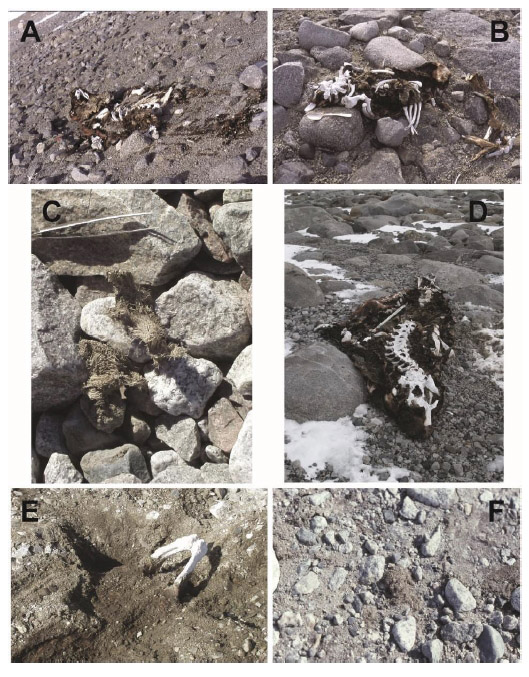
The Ross Sea is a part of Antarctica that is south of New Zealand, and in the pictures below the remains of the seals and penguins show that they had well established colonies in places where they are unable to live now. The red circles mark the seal colonies, and the blue stars show the penguins. The colonies ebbed and flowed but then were lost as the Little Ice Age began and have not recovered.
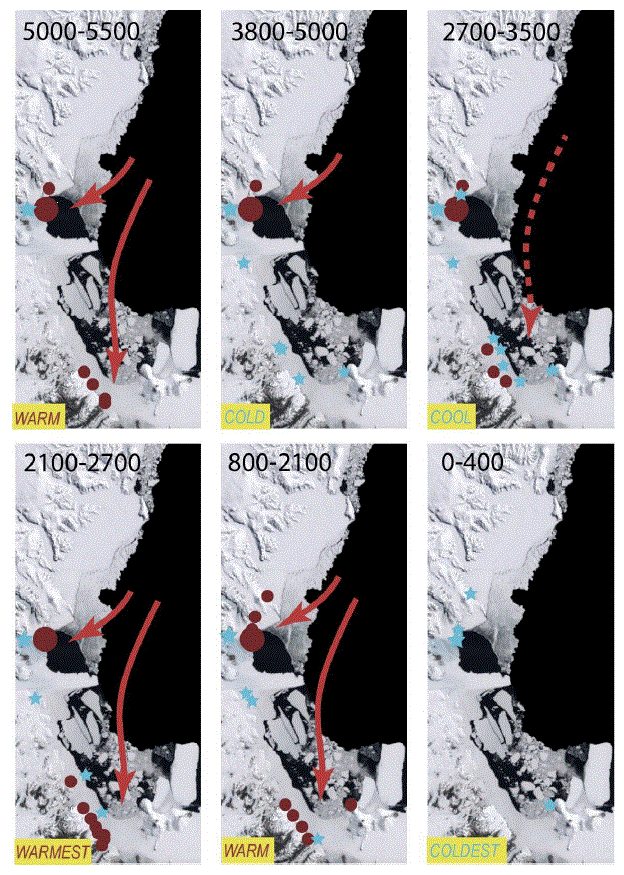
Today the beaches are an empty wasteland:
Today, the beaches are largely free of marine mammals and birds; skuas (Stercorarius maccormicki) are the most widespread species. Along the southern coast, penguins are absent, although small Adélie (Pygoscelis adeliae) rookeries existed in the past (i.e., Baroni and Orombelli, 1991, 1994a; Emslie et al., 2007). Adélies also occur adjacent to Terra Nova Bay at Adélie Cove and Inexpressible Island. Solitary or small groups of Weddell seals (Leptonychotes weddellii) occasionally haul out on the VLC. No other seals use these beaches at present.
The seals and penguins of Antarctica must be desperately hoping for some global warming so they can return to their ancestral homes and flourish where only desolate ice grips the sea and shore now. If only humans could do something about that!
Indeed, it’s time to launch a new campaign: “Fossil fuels can save the seals”. (It has just as much scientific validity as any eco-campaign running today, ask the IPCC!).
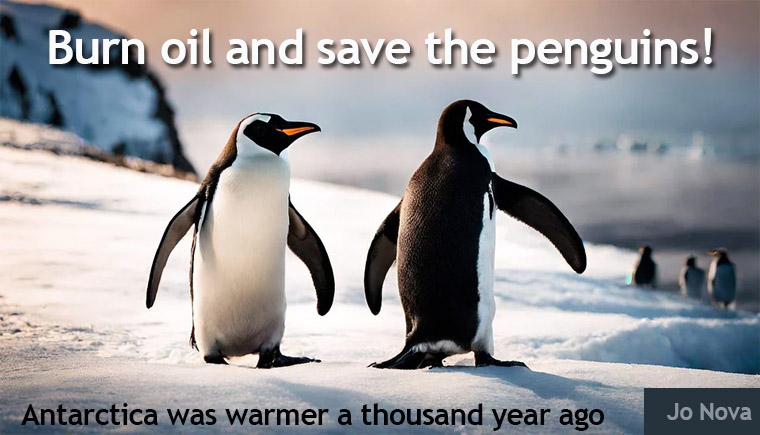 …
I don’t believe human emissions can warm the planet enough for the penguins to notice, but what if I’m wrong?
There really was a “Penguin Optimum” at about the same time as the Minoans and the Myceneans thrived. Bring back the warmth!
The red and yellow bars mark warmer eras where the marine mammals flourished. The diatom results marked in blue at the bottom (F. curta) of the graph below, show how sea ice expanded in the last thousand years as the cold made life impossible for the seals and penguins. The diatom results marked in red (T. antarctica) rise in the eras of longer warmer summers. The graph above runs “backwards” in time from right (the past) to left (present).
 Fig. 7. Synthesis of Holocene climate records from the northern VLC discussed in the text. A. Age distribution of seal remains at Terra Nova Bay. B. Cadmium/phosphorus ratios of penguin guano at Inexpressible Island, inferred to be a proxy for the presence of modified circumpolar deepwater in Terra Nova Bay (Xie et al., 2021). C. Diatoms from a marine core at nearby Wood Bay (Fig. 1; Megzec et al., 2017), inferred to represent sea-ice extent (F. curta (blue) – high % = more sea ice) and summer temperature/duration (T. antarctica (red) – high % = warmer/longer summer). Green bar and arrow at the top of the figure denote the penguin optimum (Baroni and Orombelli, 1994) and decline of penguin rookeries at southern mainland locations. Red and yellow bands are from Fig. 6 and indicate times of relative warmth inferred from the elephant seals. Tell the children, the world was warmer a thousand years ago, and the cooling has been a killer. If they like life on Earth, they want more warming, not more cooling. The world has been cooling for 5,000 years, and if we could warm the Earth that would be a good thing.
See these posts for references:
REFERENCE
Hall et al (2023) Widespread southern elephant seal occupation of the Victoria land coast implies a warmer-than-present Ross Sea in the mid-to-late Holocene, Quaternary Science Reviews, Volume 303, 1 March 2023, 107991
10 out of 10 based on 76 ratings
10 out of 10 based on 8 ratings
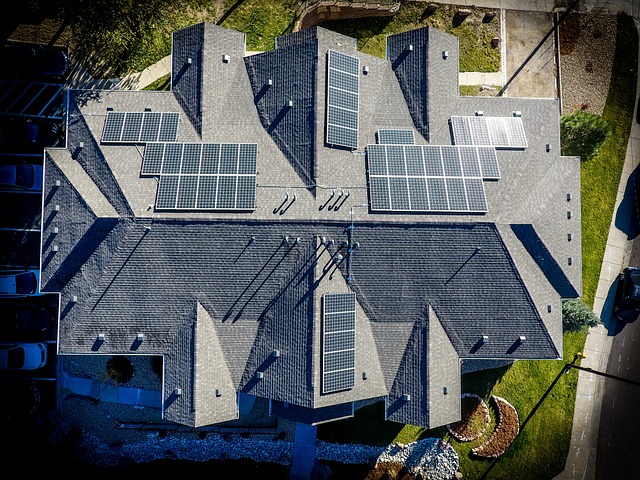 By Jo Nova By Jo Nova
California was the Land of Solar Panels at the top of the Magic Subsidy Tree but that boom went bust
If solar panels were actually cheap and useful, everyone could have them, they’d pay for themselves, and there would be no point where the panel-party would grind to a halt. But if they were expensive, made something useless, and their product became toxic to the grid itself the government would have to artificially subsidize them to get them onto the grid in the first place, and then pop its own bubble before the bubble popped the grid. And so that time has arrived in California and there is carnage in the market.
The Duck has quacked
In a strange coincidence the Californian government cut the payments for solar-powered-electricity by 75% last year, and sales of solar panels fell to a quarter of what they were a year ago. That’s a “to” not a “by”. One in five solar contractors has already left the market. Careers and businesses — gone.
The new price for solar-powered-electricity is probably slightly closer to the true market value, which is almost zero, or even less for holy-green electricity at noon. The Duck Curve is the shape the daily load curve makes. As more and more solar panels are added to the grid the demand for electricity falls at midday, but stays the same at breakfast and dinner. So the amount of electricity required for the state gradually develops a “belly” at noon, and looks like a duck. As more solar panels are added, the grid ends up with too much electricity at midday, which is such a problem it has to pay someone else to use it. In a real free market, negative wholesale prices at midday should have killed off the solar panel rooftop industry years ago.
by Phred Dvorak, The Wall Street Journal
Nation’s biggest residential solar market is tanking and installations could decline 13% nationwide, despite clean energy push
The state has installed so many panels that it has a glut of solar power during the day. Last year, California implemented new rules that cut the amount of compensation most rooftop solar owners get for the electricity they send to the grid by 75% or more to manage the oversupply and soaring costs for upgrading the grid.
Residential solar sales have dropped to a quarter of what they were a year ago, and more than a fifth of the state’s solar contractors have been laid off, according to some estimates.
“It was like getting a gut punch,” says Carlos Beccar, marketing director of Fresno-based Energy Concepts, a solar installer that had to lay off more than half its 75 employees after sales plummeted as much as 90% following the new rules.
The journalists spin the solar excuses
At the same time, California’s solar growth is outpacing the ability of its grid to handle it.
It’s not that solar-electricity is a useless toxic byproduct of subsidies, it’s that solar is so good, the grid is not ready for it. In other words, it’s all your fault. You need to pay more for that grid “upgrade”, or storage, or something so the little solar flowers can thrive.
Who knew, the job of the grid was not to supply electricity, but to “absorb” the subsidy farmers:
The state already supplies more than a third of its power with renewables, and it plans to raise that ratio to 60% by 2030. But because the state’s grid can’t absorb all the solar power generated during the day, it ends up throwing increasing amounts of it away or curtailing it.
Get ready, the next step is to corral us into paying more to solve the mess they created:
Part of the rationale behind the state’s new solar billing rules is to encourage households to buy batteries, which can store power for use later.
See how the planned economy works? The subsidies forced useless white elephants onto the grid. The fees to cover the costs were set so the people without solar had to pay the subsidies. So their electricity bills went up until their wallets bled, and they begged to buy solar panels “because electricity costs had risen”. Then the government changed the conditions so that people with solar really needed to buy a battery …
More than 30% of homes in Australia have solar panels installed. In California, in 2019 apparently 44% of homes had solar panels. But as extreme as that is, California is connected to other states in the US, so it can offload the extra electricity, or upload electrical juice from other reliable generators. Australia doesn’t have that option. We have to put the spare electricity in shoe boxes and float it over to Papua New Guinea.
Image by Charlie Wilde from Pixabay
9.9 out of 10 based on 102 ratings
8.2 out of 10 based on 5 ratings
“We are more divided as a nation than ever and are feeling increasingly disillusioned and disempowered.”
Hon. John Anderson | Brendan O’Neill (Spiked Magazine) | Tony Seabrook (PGA) | Janet Albrechtsen (The Australian) | Jennifer Grossman (CEO of the Atlas Society) | Scott Hargreaves (IPA) | Professor Stephen Wilson | Professor Simon Haines (Ramsay Centre for Western Civilization) | Dr. Bella D’abrera | Russell Delroy | Steve Whybrow Sc | Professor Gary Banks | Gemma Tognini | Dan Ryan | Brianna Mckee | Freya Leach | Ron Manners (Mannkal)
Sydney, April 23rd | An evening with Brendan O’Neill (CIS)
Sydney, April 30th | Australia’s Nuclear Future (CIS)
10 out of 10 based on 21 ratings

By Jo Nova
Electric cars and carbon target fantasies are hitting the wall
Right when they are meant to be growing by double digits German EV car sales are down an astonishing 30% compared to a year ago. Their market share is actually shrinking. EV’s are not much good at reducing carbon dioxide over their lifetime but they are very useful for pretending to “decarbonise” the transport sector. So this creates a vast hole in the German government’s so-called transition, which has fixed targets for every sector. Problematically, the transport sector just doesn’t seem to run on wind and solar panels, or pumped hydro. It’s hard to decarbonize. Liquid fuel is just too convenient.
It seems the German Transport Minister is threatening to ban weekend driving as an ambit claim to expose the absurdity of the Green’s position. He is warning that if the Greens don’t sign a change in legislation to average emission across all sectors, he will have to take drastic action to meet the transport sector goals, which means banning driving on weekends. (Trap set.)
The Greens responded like any petty tyrants would, saying he shouldn’t aggravate people unnecessarily, because there were other ways to fix the climate, like forcing everyone to drive slower. (Trap sprung.) The Greens stepped right into it:
“This claim is simply wrong,” Green parliamentary group leader Julia Verlinden told the German Press Agency, referring to Wissing’s threat of a weekend driving ban. She added that Wissing should not aggravate people unnecessarily because there are other ways to tackle climate issues, such as a speed limit. — Politico
Naturally, at the next election, policies that make people drive slower to stop storms 80 years from now will sink like a boat full of burning cars.
Volker Wissing (the Transport Minister) is a member of the Free Democratic Party (FDP) which is theoretically a centre right party. Because the German government is a “traffic light coalition” of three different parties, he needs to work with the Greens to get legislation passed, but he doesn’t have to help them win the next election.
As Pierre Gosselin at NoTricksZone points out the German government are not even close to hitting their EV targets: “The massive sales drop is bad news for the current German socialist-green government, which aims to have 15 million vehicles on the road by 2030. Currently there are just 1.4 million!”
So they’re 13.6 million cars short with only 5 years and 9 months to get there. At the current rate of sales they’re going miss their target by 11 million cars.
Germany’s ambitions to take a leading role in electromobility suffered a severe setback in the first quarter of this year. A significant drop in sales is emerging. Only 31,384 electric vehicles were newly registered in March, a drastic decrease of 28.9 percent compared to the previous year. The collapse in registrations contrasts with the political goals and underlines the gap between political planning and actual market conditions. The challenge lies in whether political measures are effective enough to counter consumer preferences and market dynamics
Electric car shock: market share falls to 11.9% – end of subsidies exposes Germany’s dilemma
The abolition of the electric bonus at the end of 2023 has revealed another problem. The sector’s dependence on government subsidies became visible. This has further exacerbated the crisis of confidence in the electric car market.
And so we arrive at the ugly point where the planned economy meets the real one:
By Šejla Ahmatović Politico, [Translated by Google]
The ruling coalition has been fighting over legislation that sets out binding climate targets.
Germany’s transport minister is threatening to ban driving on weekends to meet climate goals if the ruling coalition does not pass reforms to the Climate Protection Act by July.
A reduction in traffic to help meet the climate goals would only be possible through measures that are difficult to communicate to the public, such as “comprehensive and indefinite driving bans on Saturdays and Sundays,” Wissing added.
All Wissing is asking for is to spread the emissions reductions over other sectors:
The planned amendment to the emissions-reduction law allows climate goals to be reviewed for compliance by looking at all sectors together instead of individually. If the overall target is missed two years in a row, then the federal government is to decide in which sector and with which measures the permitted total amount of carbon dioxide emissions is to be achieved by 2030.
If the planned reforms are not passed through parliament by July 15, Wissing warned, the Ministry for Digital and Transport would be obliged to submit an “immediate action program that ensures compliance with the annual emission levels of the transport sector” until 2030 — which would include a driving ban on weekends.
Wissing has already said the government is not looking to put speed limits on highways. He’d probably quite like it if the Greens adopt that policy at the next election. The Greenpeace mobility expert (as if there is such a thing) is Clara Thompson who said that Wissing was coming up with “horror” scenarios to distract from his own failures. But at least as far as Politico reports it, she didn’t have any suggestions of how to solve electric vehicle nightmares with frozen batteries, slow charging, expensive repairs, car sickness, combustible materials, and holiday hell stories.
h/t John Connor II
10 out of 10 based on 92 ratings
8.7 out of 10 based on 13 ratings
8.2 out of 10 based on 22 ratings
9.4 out of 10 based on 13 ratings
By Jo Nova
Right about now the Greens should be rushing to reverse all the plastic bans
Now we know that CO2 is aerial fertilizer and feeds the world, but this study highlights the crazy unscientific randomness of environmental policies chanted by the same people who say “follow the science”.
It turns out paper shopping bags produce five times as much CO2 over their lifetime as plastic HDPE bags do. Apparently, plastic bags might strangle a turtle, but in the mind of a dedicated Green, paper bags could be causing the sixth mass extinction. Oh the dilemma?
A new study in Environmental Science and Technology looked at 16 applications of plastics in modern life found that in 15 of them, the plastic version produced fewer emissions than the paper, concrete, steel, glass or aluminum sort. And these 16 applications accounted for about 90% of global plastic volume. It seems that with paper bags people often “double bag” their groceries because the bags are prone to breaking, and in the end, in landfill, the paper waste is degraded into methane.
Steven Hayward, Powerline
So we went and banned plastic straws and plastic bags in much of California and elsewhere because they are made from fossil fuels and a solitary turtle was once found snorting fentanyl through a plastic straw, or something. In any case, Greta/Gaia was displeased, so plastic products had to go.
Well guess what: the substitutes for plastic products mostly produce higher greenhouse gas emissions than plastic. Not by just a little but by a lot.
If the Greens gave a toss about CO2 emissions, you’d think they’d be pretty careful to make sure their own plans were not wrecking the planet. And, ipso facto, oops, if they did the wrong thing, you’d think they’d want to fix that like all life on Earth depended it? Unless, of course, they were attention seeking totalitarians who just wanted to boss people around for the sake of it?
This is not the first time studies like these have surfaced. We know from what the EcoWorriers won’t do, that they don’t give a damn about carbon emissions. It’s all a big show of virtue signalling, a grand theatre where they pretend to care, and their friends pretend to be impressed.
Only people who want to fry coral reefs would choose paper bags over plastic ones, eh?
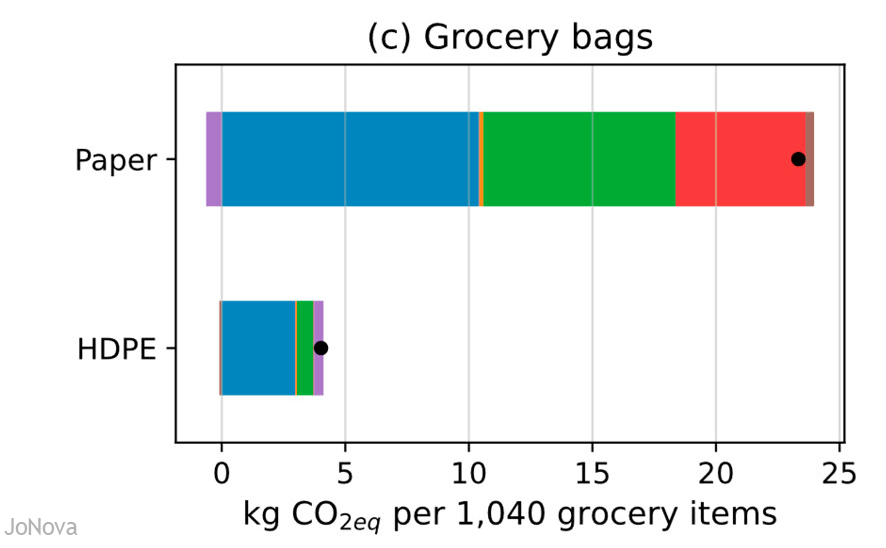

Even though we don’t recycle PET bottles much, they produce one half the emissions of cans, and one third of the emissions of glass:
PET bottles have the lowest emissions impact because of their low weight and low energy intensity during production. In comparison, aluminum cans release twice the emissions of PET bottles, and glass bottles release three times the emissions. PET has the lowest recycling rate (Table S3) among the three alternative containers and the highest emissions when incinerated at end of life (WtE). However, in this case, the production stage dominates the overall emissions, and here, PET has a much lower impact than glass and aluminum (Figure S3).
 https://pubs.acs.org/doi/10.1021/acs.est.3c05191 Could a member of Greenpeace even speak the words? PVC pipes are better for climate change (if you care about CO2):
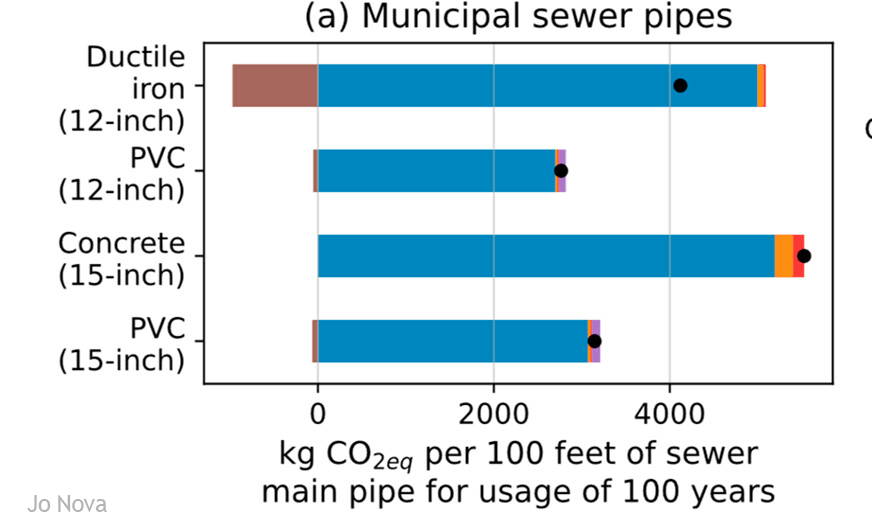
Pet food in tins produces three times the emissions of pet food in little plastic pouch things:
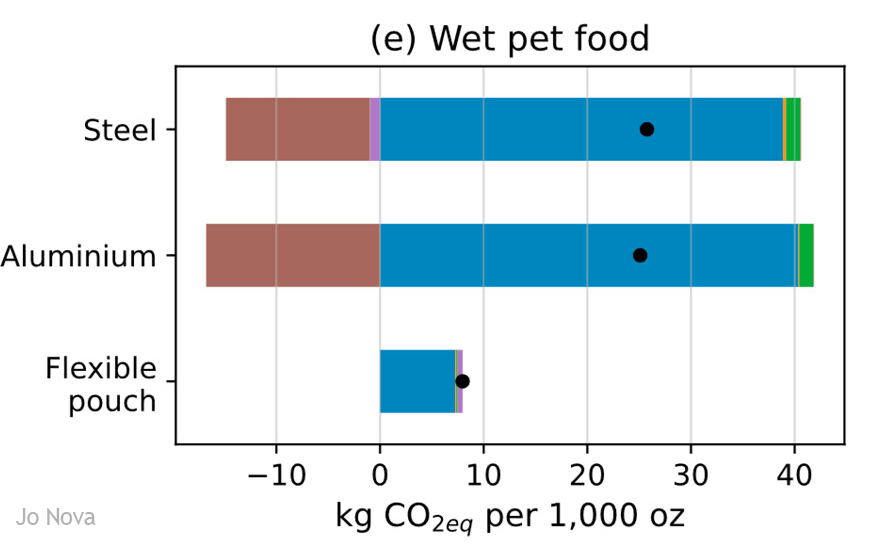
Even plastic milk bottles produce less emissions than cartons do, and every little bit matters as they say:
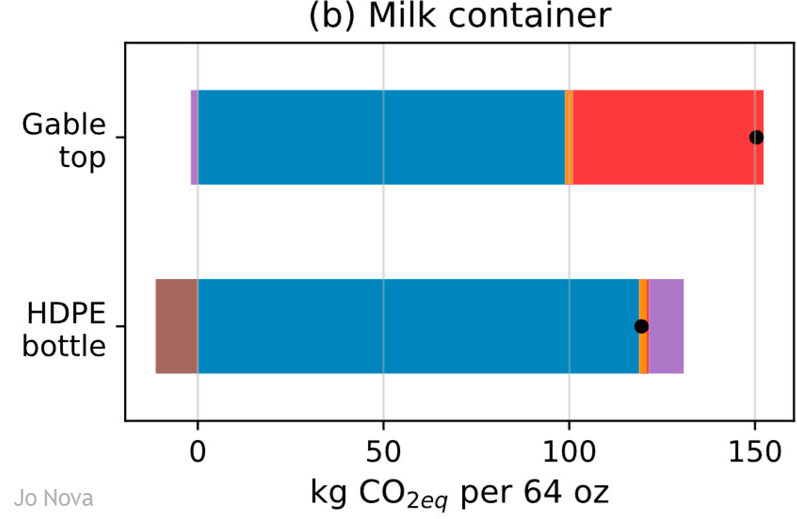
Obviously Greens will be bragging about the plastic fuel tank in their hybrid cars, right?
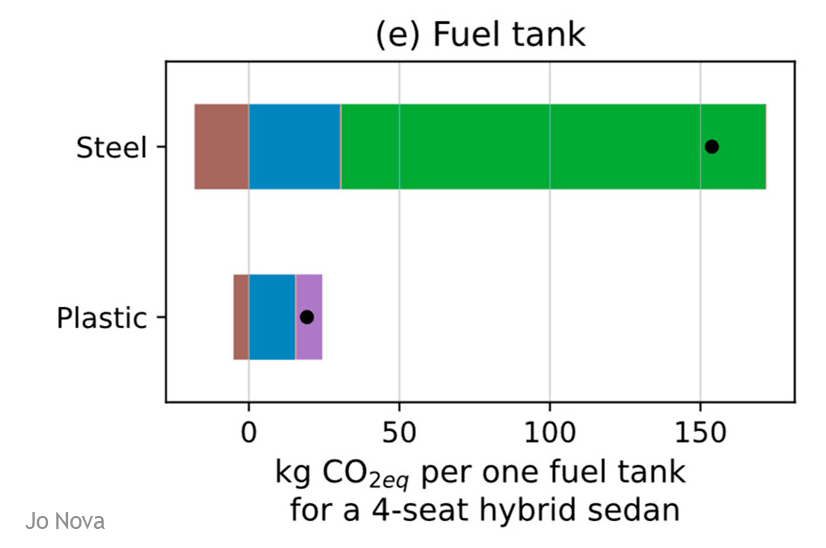
…and their acrylic carpet. Save the whales, buy linoleum?
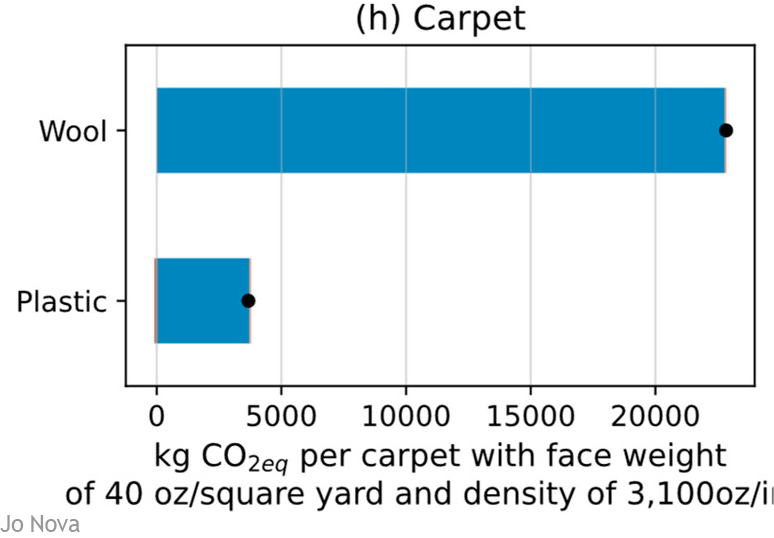
The whole study finds virtually no reason to swap plastic goods for something else:
We conclude that applying material substitution strategies to plastics never really makes sense. This is because plastics’ inherent properties─strong, lightweight, easy to shape, customizable, and comparatively low-GHG emissions─make it the preferred material for minimizing emissions across most products.
h/t Bally
REFERENCE
-
Fanran Meng, Miguel Brandão, and Jonathan M Cullen
Environmental Science & Technology 2024 58 (6), 2716-2727
DOI: 10.1021/acs.est.3c05191
9.9 out of 10 based on 81 ratings
8.7 out of 10 based on 7 ratings

By Jo Nova
Politicians are supposed to care about the voters, but trillions are being spent on a issue that voters don’t give a toss about. Who are politicians serving exactly, because it isn’t the voters. There is no grassroots clamoring demand for “climate action” and there never was. Could it be that politicians are more worried about what the banker cartel think, and the media moguls, or President Xi, or are they just carving out a post-political job for themselves at the UNEP or the WEF?
The Wall Street Journal reports on a survey that shows even young voters know almost anything is more important than climate change.
By Amrith Ramkumar and Andrew Restuccia,Wall Street Journal
A Journal poll, which surveyed voters in seven swing states in March, found that just 3% of 18-to-34-year-old voters named climate change as their top issue, with most citing the economy, inflation or immigration. That is roughly in line with voters of all ages, 2% of whom cited climate change as their top issue.

This has been this way for years. In 2015 only 3% of US voters thought climate was the most important issue.
And let’s not forget all these surveys are done on people who never see a skeptical expert on TV or a real documentary (like Climate: The Movie). They don’t hear that carbon dioxide was higher for most of the last half billion years, or that “climate change” causes record grain yields, and saves 166,000 lives a year. Most of the 18 to 35 year olds have been fed the climate diatribe from school — but even they don’t believe it. If they thought the Antarctic icecap was really about to collapse, they’d rate climate change up there with inflation.
Given the vapor thin faith of the young and impressionable, the whole climate charade is a house of cards. One good opposition leader just has to point out the costs and start the debate and it’s over. Everyone wants to change the climate until the moment they have to pay for it.
A survey from the Climate Communications unit at Yale suggests the climate gravy-train isn’t buying votes either. 55% of US voters don’t think the trillion dollar Inflation Reduction Act will improve their health. Two thirds don’t think it will help their family. 54% of voters don’t think it will help their children or grandchildren.
If you were a politician trying to win votes, this is not how you’d spend a trillion dollars.
Fewer than half of registered voters think the Inflation Reduction Act (IRA) will help them or the country.
-
-
- Future generations of people: 46% of registered voters; 78% of liberal Democrats, 67% of moderate/conservative Democrats, 30% of liberal/moderate Republicans, and 14% of conservative Republicans.
- The health of Americans: 45% of registered voters
- Low-income communities and communities of color who are disproportionately harmed by pollution: 40% of registered voters;
- The economy and jobs in the U.S.: 38% of registered voters
- Their family: 33% of registered voters
- Them personally: 30% of registered voters
- National security: 20% of registered voters
And therein lies the grand mystery of democracy. We basically have a giant government industry spending a trillion dollars on an issue people don’t care about and in ways that most voters don’t think will help them, their children, the poor, the economy, jobs or national security. And yet the money flows. Why is that?
Just ask “Who Benefits?”
So the good news that the young can see through this, despite the wall of propaganda.
The bad, awful and terrible news is that the government doesn’t care what the voters think.
h/t Peter
Image by Meranda D from Pixabay
10 out of 10 based on 109 ratings
9.4 out of 10 based on 7 ratings
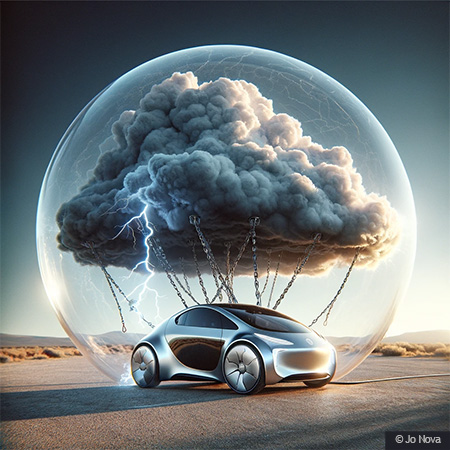
By Jo Nova
It’s just another day in the death of the early 21st Century EV bubble
The fantasy of battery powered vehicles that also fix the weather was foisted upon the people by Big Government. But all the regulatory wands in the world, and even billions in free gifts don’t make a market appear when the product is a dog.
EV’s are meant to be storming the market on their way to domination. But in the UK the market share of EV’s rose only 3.8% last month but the whole car market grew by 10% — so EV’s are in danger of becoming a shrinking part of the UK car fleet. Plug-in hybrids saw a 37% increase.
The EV experiment has gone so very wrong. Last year Ford was the number 2 EV brand in the US, but it was hit with the $4.5 billion dollar black hole of fiscal carnage, losing $38,000 on every single EV. Obviously, something had to change, and now months later, Ford is abandoning plans to bring in two new EV models, and retool their EV manufacturing plants. Instead, it is shifting to hybrid vehicles — copying the Toyota plan.
David Blackmom, The Telegraph
Something big is happening in the US market for battery electric vehicles (EVs), and it isn’t positive for the industry that makes them, or for the Biden administration’s subsidised dreams.
Ford suddenly puts the brakes on EV models, and factories, and is copying Toyota which was mocked and ridiculed for focusing on hybrids instead of the purist EV’s:
…on April 4, Ford Motor Company put the icing on this cake of electric carnage with an announcement that it is pulling back from plans to introduce two new EV models, an SUV and another pickup to tag along with the F-150 Lightning, and delaying major investments in building and “retooling” EV manufacturing plants in the US and Canada.
Ford says that after three years of making massive investments in new plant and equipment needed for the production of its F-150 Lightning and electric Mustang Mach E models, it will now focus on developing hybrid options across its entire model lineup. This places Ford on a strategic path similar to Japanese giant Toyota, which has become an object of scorn and ridicule from the climate alarmist left and globalist policymakers in the US and Europe for its stubborn, ongoing focus on making and successfully selling hybrids rather than pure EVs.
Meanwhile Fisker, a new EV startup, is pausing production for three weeks, and is on the verge of bankruptcy. Things are so desperate they have dropped the price of the “Ocean Extreme” from £58,000 to £44,000 in the hope of staving off the grim reaper. Not surprisingly, after sales support is “not guaranteed”.
Resistance is growing downunder
The Guardian is still giving free adverts for EVs and pretending its news. They report that there are now 180,000 EV’s in the Australian market, but don’t mention that that is a mere 1% of the total car fleet.
In Australia the EV market is in its infancy, but people already seem to realize “they catch fire” a lot. In the driest continent with the lowest population density and most expensive electricity on Earth, range anxiety and fear of fire is real thing. Far from being excited about being offered low emissions cars, there are signs from middle Australia that the people are unimpressed already.
Dissent is so strong, people in Strata-title buildings have to struggle for 12 months to even get one EV installer added to the building. And when they do succeed the charging spot is often placed in the furthest part of the carpark, out in the garden, lest it combust. One contractor has quoted to install an EV charging outlet on 100 buildings but only two have taken the job up. “Resistance is growing” he says:
It has taken somewhere near 12 months — 3 Body Corporate Committee meetings, dozens of emails, an Extraordinary General Meeting and an Annual General Meeting to get to this stage — a single 10amp GPO.
To date, he has quoted to install the electrical backbone infrastructure in over 100 buildings. It works out at roughly AU$1000 per parking bay. Only two buildings have taken up the quotes. He believes that body corporates are looking for more reasons to resist the change. “There appear to be more and more rules and regulations,” he says.
“In apartment blocks there are so many people to deal with: committees; on site management. I think the resistance is growing. Some are using fire risk as a means to stop installs. Quotes have become more expensive and more complex as I have had to add fire extinguishers, smoke detectors, fire blankets and a stop/start button. Safe EV training has to be provided for those responsible in the building. More work, more cost.”
And the unsold cars pile up in the US:
10 out of 10 based on 94 ratings
9.3 out of 10 based on 9 ratings

By Jo Nova
 … Dear Australians, people are sneaking into your house and stealing your money every year. You may have no idea because the theft comes in one thousand little instances, hidden within labels like “electricity bill”, “peas” and “soccer fees”. It’s also hidden in your income tax. Pagan fantasy plans to stop storms and hold back the tide are being funded by you, whether you like it or not.
Solar panel installations are partly paid for by their neighbors who don’t have solar panels, it’s hidden in their electricity bills. When a wind farm is built out past the Black Stump, shareholders of the wind farm don’t pay for the high voltage line to connect themselves to the grid, you do. When the new unreliable generators wipe out the midday profits from the old reliable plants, the old essential plants still have to pay their capital costs, insurance and staff. So they just have to charge more for the hours they do run. The new vandal plants make the old reliable ones more expensive than they would have been. (See Stacy and Taylor) You pay that bill too.
When the soccer club pays higher electricity charges for the night lights they pass that on to your eight year olds club fees. And so on and so forth for the peas, the cheese, the ham and everything that’s heated or cooled or moved in the supermarket.
If a government official knocked on your front door and demanded the “Climate-changing-cash” in a single payment, there would be hell to pay. Alan Moran has added up the numbers and it works out to $15.6 billion a year in Australia, and that’s about $600 per man, woman, and child.
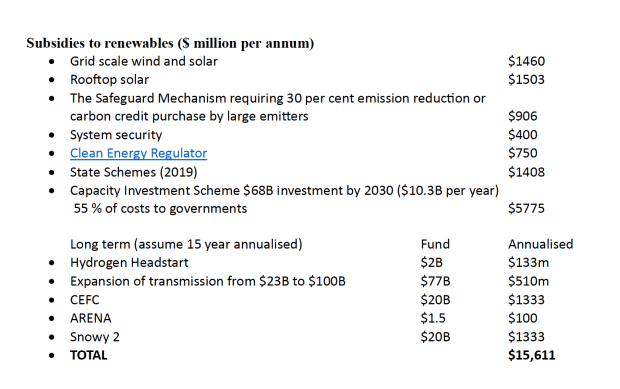
So lets have a referendum on whether we should be trying to change the weather. Let’s ask the people if they would rather have cheap electricity and a trip to Bali, or knock 0.0 degrees C off global temperatures in 2100AD? Would they rather buy a new fridge or pretend they can reduce the floods coming in one hundred years time?
We know 98% of the public say they “believe” in climate change, but we also know the renewables industry will never ever campaign for a referendum to ask what the people want. They know, we know, and the politicians know — the people don’t want to buy “the transition”.
Burglar image by Sammy-Sander from Pixabay | Thieves online image by Hyperslower from Pixabay
10 out of 10 based on 107 ratings
9.1 out of 10 based on 13 ratings
|
JoNova A science presenter, writer, speaker & former TV host; author of The Skeptic's Handbook (over 200,000 copies distributed & available in 15 languages).

Jo appreciates your support to help her keep doing what she does. This blog is funded by donations. Thanks!


 Follow Jo's Tweets
Follow Jo's Tweets To report "lost" comments or defamatory and offensive remarks, email the moderators at: support.jonova AT proton.me
Statistics
The nerds have the numbers on precious metals investments on the ASX
|







 By Jo Nova
By Jo Nova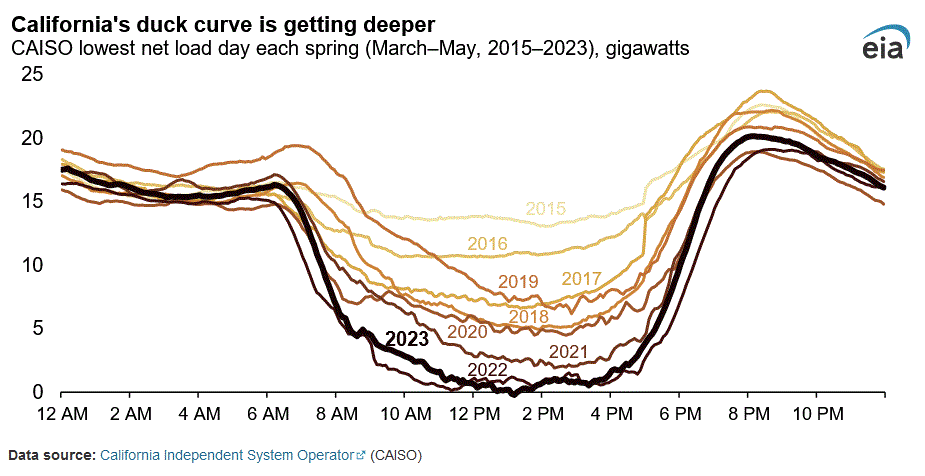


























Recent Comments